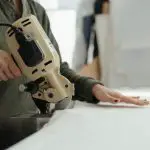Are you ready to learn how to cut linen fabric like a pro? In this article, we’ll guide you through the process step by step.
You’ll discover the right tools to use, how to prepare the fabric, and techniques for measuring and marking your cutting lines.
Whether you prefer scissors, a rotary cutter, or a fabric cutting machine, we’ve got you covered.
Plus, we’ll share tips for cutting linen fabric with patterned designs.
Let’s get started!
Table of Contents
Choosing the Right Tools for Cutting Linen Fabric
To choose the right tools for cutting linen fabric, you’ll need a sharp pair of fabric scissors and a rotary cutter. When it comes to cutting techniques, it is important to ensure that your tools are sharp and in good condition. Dull scissors can result in frayed edges and make it difficult to cut through the fabric smoothly. Before starting, make sure to measure and mark your fabric accurately to avoid any mistakes.
Safety precautions are crucial when working with sharp tools, so remember to always keep your fingers away from the blade and cut in a well-lit and clean workspace. Additionally, it’s advisable to use a cutting mat underneath your fabric to protect your work surface and prevent the blade from dulling.
When using a rotary cutter, hold it firmly with a relaxed grip and apply even pressure as you cut. Remember to take breaks if you’re feeling fatigued to prevent any accidents. By choosing the right tools and following these cutting techniques and safety precautions, you’ll be able to cut your linen fabric with ease and precision.
Preparing the Linen Fabric for Cutting
Before you can begin cutting your fabric, it’s important to properly prepare it. This involves techniques such as washing, ironing, and marking the fabric.
Additionally, having the right cutting tools and knowing the proper methods for cutting can greatly impact the outcome of your project.
Fabric Preparation Techniques
Start by prewashing the linen fabric to remove any shrinkage before cutting. This will ensure that your final garment or project retains its shape after washing. When it comes to fabric cutting techniques, accuracy is key. To cut straight lines, use a rotary cutter with a sharp blade and a cutting mat to protect your work surface. Measure and mark your fabric accurately using a clear ruler or measuring tape. To help maintain straight lines, consider using a straight edge or a metal ruler as a guide. Take your time and cut slowly, applying even pressure to prevent the fabric from shifting. Following these fabric cutting techniques will result in clean, precise cuts and ensure the success of your sewing or crafting project.
| Fabric Cutting Techniques | Cutting Straight Lines |
|---|---|
| Prewash the fabric | Use a rotary cutter |
| Measure and mark | Use a cutting mat |
| Use a straight edge | Cut slowly |
| Apply even pressure | Prevent fabric shift |
Cutting Tools and Methods
You can achieve clean and precise cuts by using a rotary cutter with a sharp blade and a cutting mat.
When cutting linen fabric, it’s important to use the right tools and techniques to avoid fraying.
Start by placing your fabric on a self-healing cutting mat to protect your work surface and provide a stable base.
Hold the rotary cutter firmly and glide it smoothly along the fabric, using a ruler or straight edge as a guide for straight lines.
For curves or intricate shapes, make small, controlled movements.
Remember to change your blade regularly to maintain sharpness and prevent snagging or fraying.
With the right tools and techniques, you can achieve professional-looking cuts and avoid unwanted fraying on your linen fabric projects.
Measuring and Marking the Cutting Lines
To measure and mark the cutting lines accurately, use a fabric ruler or measuring tape. These tools will help you ensure precise measurements for your linen fabric. When measuring, make sure to lay your fabric flat on a smooth surface to avoid any distortions.
Take your fabric ruler or measuring tape and align it with the edge of the fabric. Use your fingers to hold it firmly in place and then slide it across the fabric, following the desired measurement. Make sure to double-check your measurements and take note of any critical points or markings.
Common cutting mistakes that you should avoid include not measuring accurately, rushing through the process, and not using the proper tools. When measuring, be patient and take your time to ensure accurate results. Rushing can lead to incorrect measurements and ultimately impact the final outcome of your project.
Additionally, using the wrong tools, such as using a regular ruler instead of a fabric ruler, can also lead to inaccurate measurements. Taking the time to measure and mark your cutting lines accurately will save you from potential mistakes and ensure that your linen fabric is cut precisely for your project.
Using Scissors to Cut Linen Fabric
When using scissors, remember to hold them firmly and make smooth, controlled cuts along the marked lines. This is crucial when cutting linen fabric, as it is a delicate and easily frayed material. Follow these cutting techniques to achieve clean and precise cuts on your linen fabric:
-
Choose the right scissors: Opt for sharp fabric scissors that are specifically designed for cutting textiles. This will ensure clean cuts without causing excessive fraying.
-
Hold the fabric taut: Before cutting, make sure to hold the fabric taut with your non-dominant hand. This will prevent the fabric from shifting and ensure accurate cuts.
-
Cut in one continuous motion: Instead of cutting in short, choppy strokes, aim to make one continuous motion with the scissors. This will result in smoother, more controlled cuts.
To help you troubleshoot common cutting issues, refer to the table below:
| Common Cutting Issue | Cause | Solution |
|---|---|---|
| Fabric fraying | Dull scissors or incorrect cutting technique | Sharpen scissors or adjust cutting technique |
| Uneven edges | Uneven tension or incorrect cutting technique | Ensure even tension and use smooth cutting motions |
| Fabric slipping | Insufficient grip or incorrect cutting technique | Hold fabric firmly and adjust grip if necessary |
Utilizing a Rotary Cutter for Precise Cuts
Using a rotary cutter can provide you with more precise cuts and smoother edges on your projects. The benefits of using a rotary cutter are numerous.
Firstly, it allows for greater control and accuracy compared to using scissors. The sharp, circular blade effortlessly glides through fabric, resulting in cleaner lines and neater cuts. Additionally, the rotary cutter eliminates the need for excessive pressure, reducing hand fatigue and strain.
To achieve precise cuts with a rotary cutter, there are a few tips to keep in mind. Firstly, ensure that your fabric is properly aligned and secured in place. This will prevent any shifting or slipping during the cutting process. Secondly, use a cutting mat underneath your fabric to protect your work surface and ensure smooth cutting. It also provides a guide for straight lines and angles. Remember to always cut away from your body to avoid accidents.
Another tip is to change the blade regularly. Over time, the rotary cutter blade can become dull, resulting in jagged edges and frayed fabric. By replacing the blade as needed, you’ll ensure consistently clean and precise cuts.
Lastly, practice makes perfect. Take your time and practice cutting on scrap fabric before tackling your actual project. With time and experience, you’ll become more adept at using a rotary cutter and achieving precise cuts.
Exploring the Benefits of a Fabric Cutting Machine
One of the benefits of a fabric cutting machine is that it can save you a significant amount of time and effort. This powerful tool is designed to precisely cut fabrics, such as linen, with ease and efficiency. By automating the cutting process, fabric cutting machines offer several advantages that can greatly improve your workflow and productivity.
Here are some key benefits of using a fabric cutting machine:
| Advantages | Description |
|---|---|
| Speed | Fabric cutting machines can cut through multiple layers of fabric at once, saving you time compared to cutting by hand. |
| Accuracy | These machines are equipped with precise cutting mechanisms, ensuring clean and accurate cuts every time. |
| Consistency | With a fabric cutting machine, you can achieve consistent results across all your fabric pieces, eliminating variations that may occur with manual cutting. |
| Efficiency | By reducing the time spent on cutting, you can streamline your production process and increase overall efficiency. |
| Versatility | These machines can handle a wide range of fabrics, including linen, making them suitable for various projects and applications. |
Tips for Cutting Linen Fabric With Patterned Designs
To achieve clean and accurate cuts on patterned designs, it’s important to position the fabric properly on the cutting mat. When working with linen fabric, pattern alignment is crucial to ensure a seamless result. Start by carefully placing the fabric on the cutting mat, making sure that the pattern lines up with the edges of the mat. This will help you maintain a consistent pattern throughout your project.
When cutting curves on linen fabric, it’s essential to take your time and use sharp fabric scissors. Slowly follow the curve of the pattern, making small cuts as needed. This will help you achieve smooth and precise curves without any jagged edges.
As you progress with your cutting, periodically check the alignment of the pattern to ensure that it remains consistent. Adjust the fabric if necessary to maintain the desired pattern alignment.
Remember to always work in a well-lit area and use a ruler or straight edge to guide your cuts. This will help you achieve straight lines and accurate measurements.
Finishing Touches and Clean-Up After Cutting Linen Fabric
After you finish cutting your linen fabric with patterned designs, it’s important to clean up any loose threads or fabric scraps to ensure a tidy workspace. Cleaning and maintaining your cutting tools is also necessary to prolong their lifespan and ensure accurate cuts. Here are some tips for cleaning and maintaining your cutting tools:
| Cleaning Tool | Steps to Clean | Frequency |
|---|---|---|
| Scissors | 1. Wipe blades with a clean cloth after each use. 2. Use rubbing alcohol to remove any adhesive residue. 3. Store in a dry place. |
After each use |
| Rotary Cutter | 1. Remove the blade from the cutter. 2. Clean the blade with warm soapy water. 3. Dry thoroughly before reassembling. |
Monthly |
| Cutting Mat | 1. Wipe with a damp cloth to remove any fabric fibers. 2. If necessary, use mild soap and water for stubborn stains. 3. Allow to air dry before using again. |
After each use |
In addition to cleaning, it’s important to troubleshoot common issues that may arise while cutting linen fabric. Some common issues include fraying edges, uneven cuts, and fabric shifting. To prevent fraying edges, consider using a rotary cutter with a sharp blade and applying a fabric stabilizer to the edges before cutting. To achieve even cuts, make sure your fabric is properly aligned with the cutting line and use a ruler or straight edge as a guide. If fabric shifting occurs, use pattern weights or pins to secure the fabric in place before cutting. By following these cleaning and troubleshooting tips, you can ensure a successful and enjoyable linen fabric cutting experience.
Conclusion
In conclusion, cutting linen fabric requires the right tools and careful preparation. By choosing the appropriate tools such as scissors, rotary cutters, or fabric cutting machines, you can achieve precise cuts.
Measuring and marking the cutting lines accurately is crucial for a successful outcome. Additionally, when working with patterned designs, it’s important to take extra care to align and cut the fabric correctly.
Remember to tidy up and clean your workspace after cutting linen fabric for a polished finish.
- Tetron Fabric for Marine Applications: Durability and Use Cases - June 18, 2025
- Tetron Fabric for Outdoor Furniture: Weather Resistance and Care - June 18, 2025
- Tetron Fabric for Wall Coverings: Style and Application Tips - June 18, 2025





